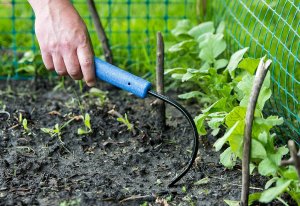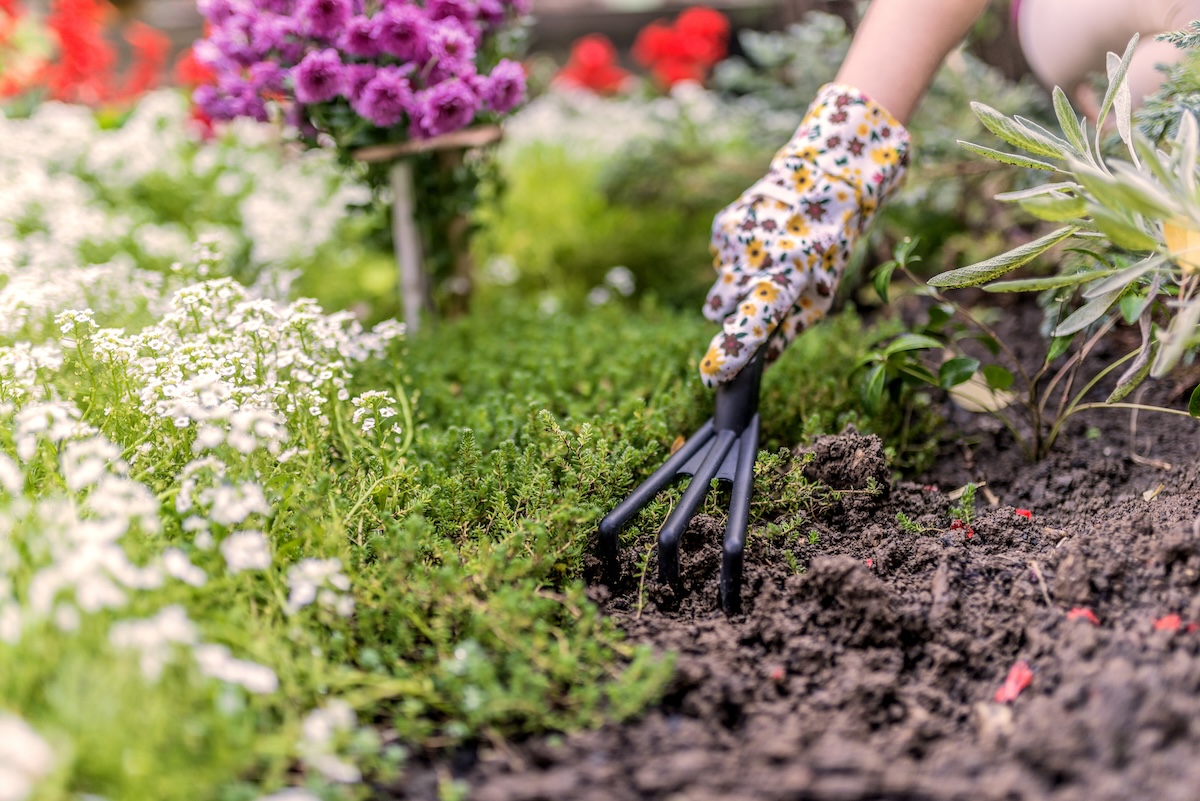

We may earn revenue from the products available on this page and participate in affiliate programs. Learn More ›
Whether you do it yourself or pay a landscaper, maintaining a vibrant garden and lush lawn requires time, effort, and money. One way to cut back on the energy and resources you put into your yard is to incorporate ground covers into the landscape. As they spread across bare ground, they suppress weeds and dust, prevent erosion, decrease water evaporation, and add color. The ground covers on this list will require little effort on your part once you plant them.
When to Plant Ground Cover
In most cases, spring is the best time to plant ground cover plants. This gives the plants’ roots time to grow and take hold before winter freezes can push them up out of the ground. Many also do best when planted in fall, but be sure to get them in the ground 6 weeks before your first expected frost. If planting a ground cover in spring, wait until the ground is workable and the danger of frost has passed.
Many factors can affect timing of ground cover planting or sowing seeds, so be sure to check the plant’s tag or local information about growing the ground cover in your zone. Other factors that might affect timing include:
- How weedy the garden bed or area is when planting. You might need to apply an herbicide to a new growing area, and this can affect when you can successfully sow ground cover seeds.
- How quickly you want the ground cover to fill in. If you need immediate coverage, don’t push the limits of the best time to plant a ground cover, or you might lose several plants. If you are patient, you can add plants every year for a few years until your groundcover fills the area. Use mulch between plants until then fill in.
- How established your perennial bed is. It is better to add larger perennials first and even let them grow a season before adding ground covers to fill the bed.
- Whether sowing from seeds or transplanting. Seeds require heat to germinate and can take longer to fill in than transplants in many cases. So be sure whether the recommended time you see is based on seeds or nursery transplants.
| Ground covers best planted in spring or fall | Coral bells Brass buttons Dead nettles Grace Ward lithodora |
| Ground covers best planted in spring | Creeping phlox Honeysuckle Creeping Jenny Stonecrop Creeping thyme Delosperma Native zinnia Yarrow Nepeta Society garlic |
| Ground covers best planted in fall | Periwinkle |
1. Coral Bells (Heuchera)
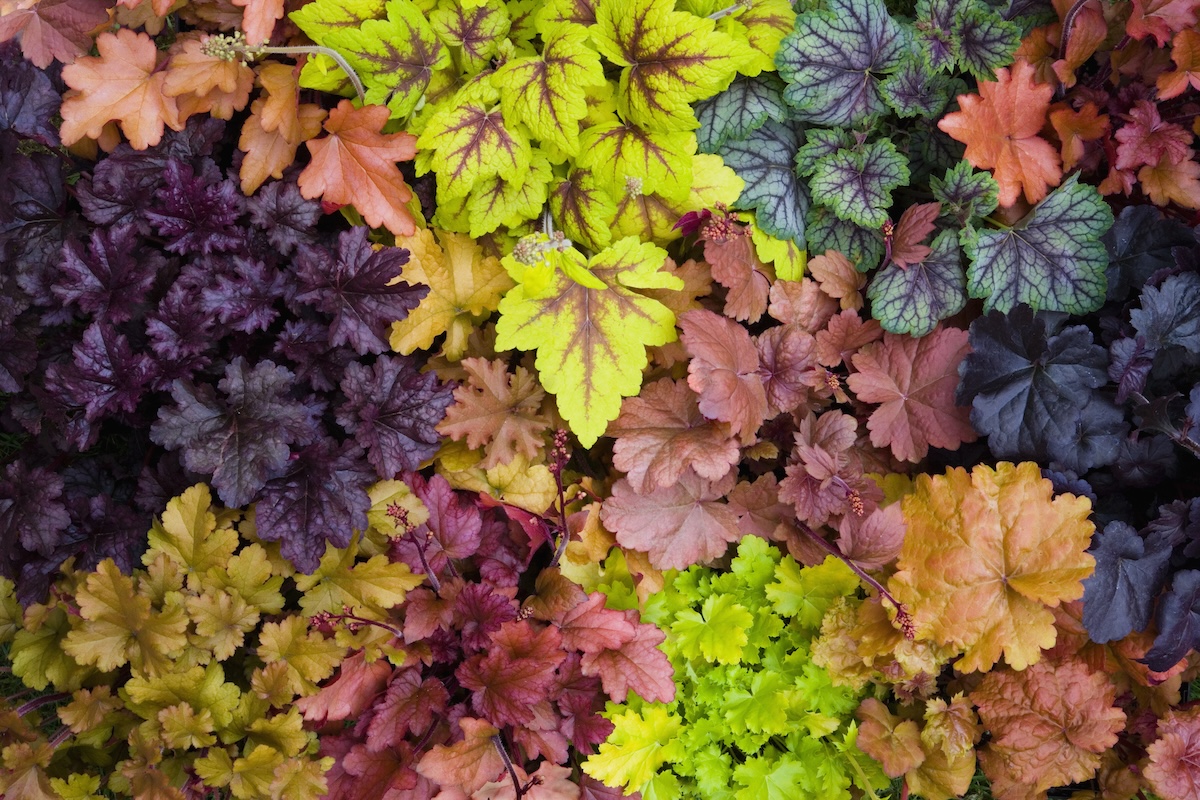
An evergreen perennial native to North America, heuchera is known for its vibrant foliage, which ranges in color from silver to green to brown. Most varieties bloom in late spring with small pink flowers above a clump of large, veined, heart-shaped leaves. When planted in groups, heuchera works well as a ground cover or along garden edging. The plant prefers well-draining but moist soil. What’s more, it requires relatively little maintenance, and is unattractive to deer and other critters.
Best for: Showy foliage for partly shady areas of the garden in just about any landscape style and most hardiness zones.
USDA hardiness zones: 3 to 9
Size: 6 to 29 inches high; 18 to 24 inches wide
Light: Partial shade to full sun
2. Honeysuckle (Lonicera periclymenum)
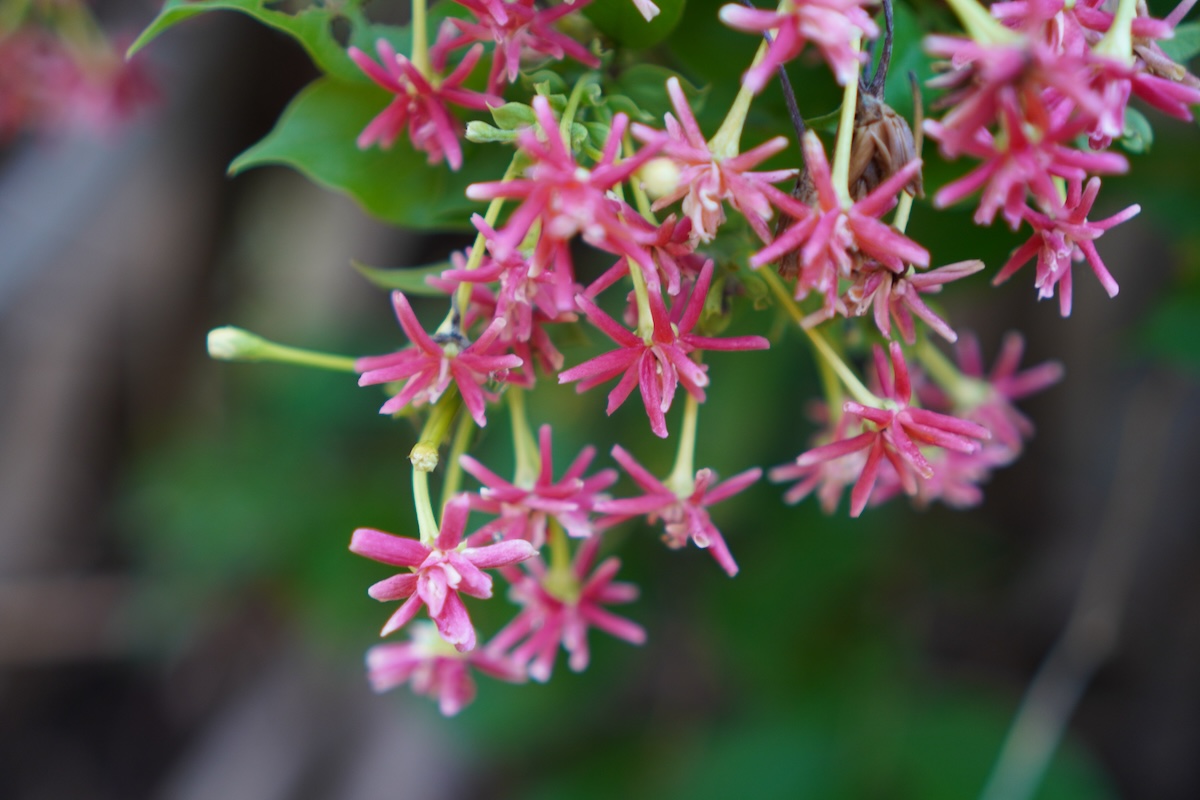
Lure hummingbirds, butterflies, and other wildlife to your garden with honeysuckle. Also known as lonicera, honeysuckle is an aromatic perennial that blooms with white, yellow, or red flowers in the spring and summer. It often grows vertically along trellises, but the plant can also serve as a ground cover.
Just beware: Honeysuckle’s rapid growth makes this an invasive plant throughout the Eastern United States and parts of Texas and the Southwest. Honeysuckle grows best with moist soil, and it’s resistant to heat.
Best for: Vining plant or ground cover with showy, fragrant flowers for areas with cool summers.
USDA hardiness zones: 5 to 9
Size: 10 to 20 feet high (or long for ground cover)
Light: Partial shade to full sun
3. Brass Buttons (Leptinella squalida)
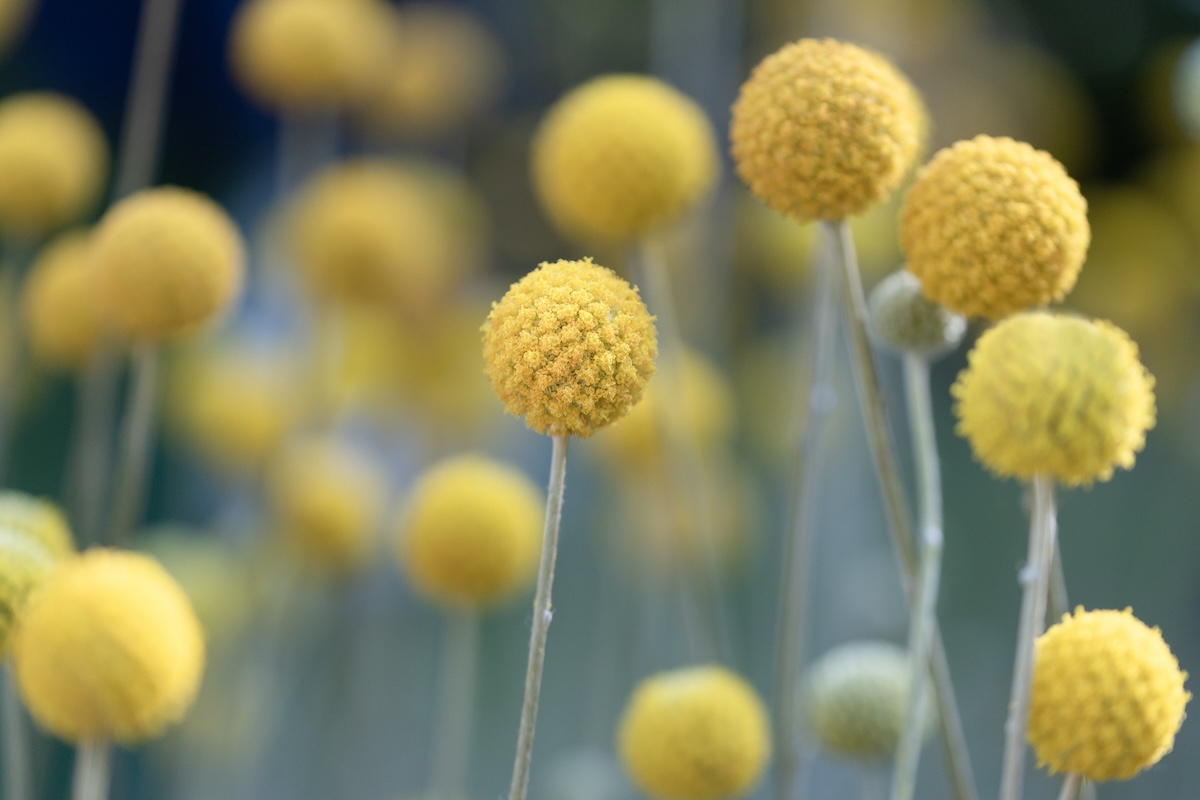
Named for the color and the shape of their flowers, brass buttons stand out perhaps most of all for their serrated, fern-like leaves. In fact, brass buttons share the same Achilles’ heel as ferns: Both succumb easily to drought. In moist soil, however, brass buttons spread vigorously, forming 2-inch-tall mats of growth strong and thick enough to withstand even regular foot traffic.
In the South or West, the ground cover may lose its leaves or die back in the cold months. It is native to New Zealand and invasive in some areas, though its spread has not been out of control. In the right climate, brass buttons remain an evergreen ground cover year round.
Best for: To provide ground cover in loose soils, especially between flagstones or along paths.
USDA hardiness zones: 4 to 10
Size: 3 inches high; 3 to 12 inches spread
Light: Full sun to partial shade
4. Creeping Phlox (Phlox stolonifera)
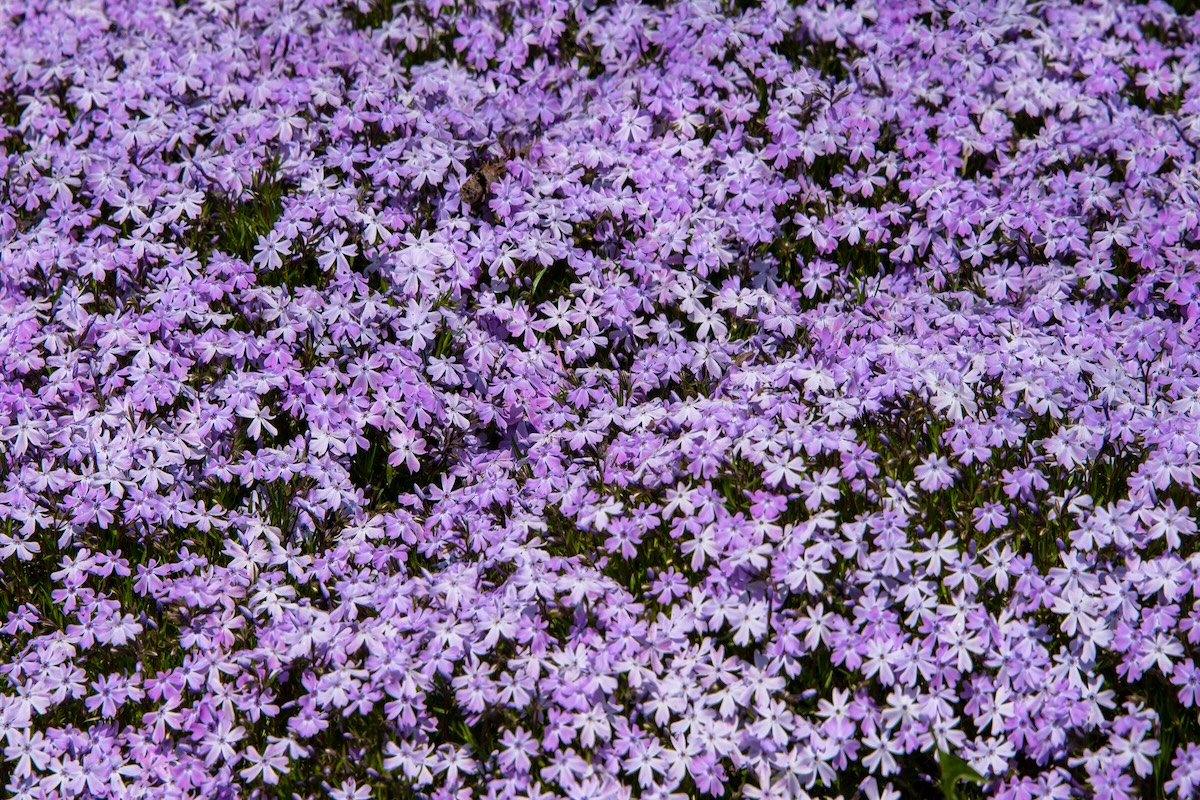
Few ground covers ever look as beautiful as creeping phlox in spring, when it produces an explosion of fragrant, star-shaped, pastel-colored flowers. It matures to a maximum height of only 6 inches, so many gardeners choose to plant creeping phlox on a slope or along the top of a retaining wall to appreciate its beauty from several angles.
As long as the site affords full sun and good drainage, creeping phlox requires next to nothing in the way of care. It’s a native to wooded areas and stream banks of the Appalachian Mountains, and easy to control.
Best for: Cascading over rocks or defining the borders of garden paths.
USDA hardiness zones: 5 to 8
Size: 6 to 12 inches high; 9 to 18 inches across
Light: Full sun to partial shade
5. Creeping Jenny (Lysimachia nummularia)
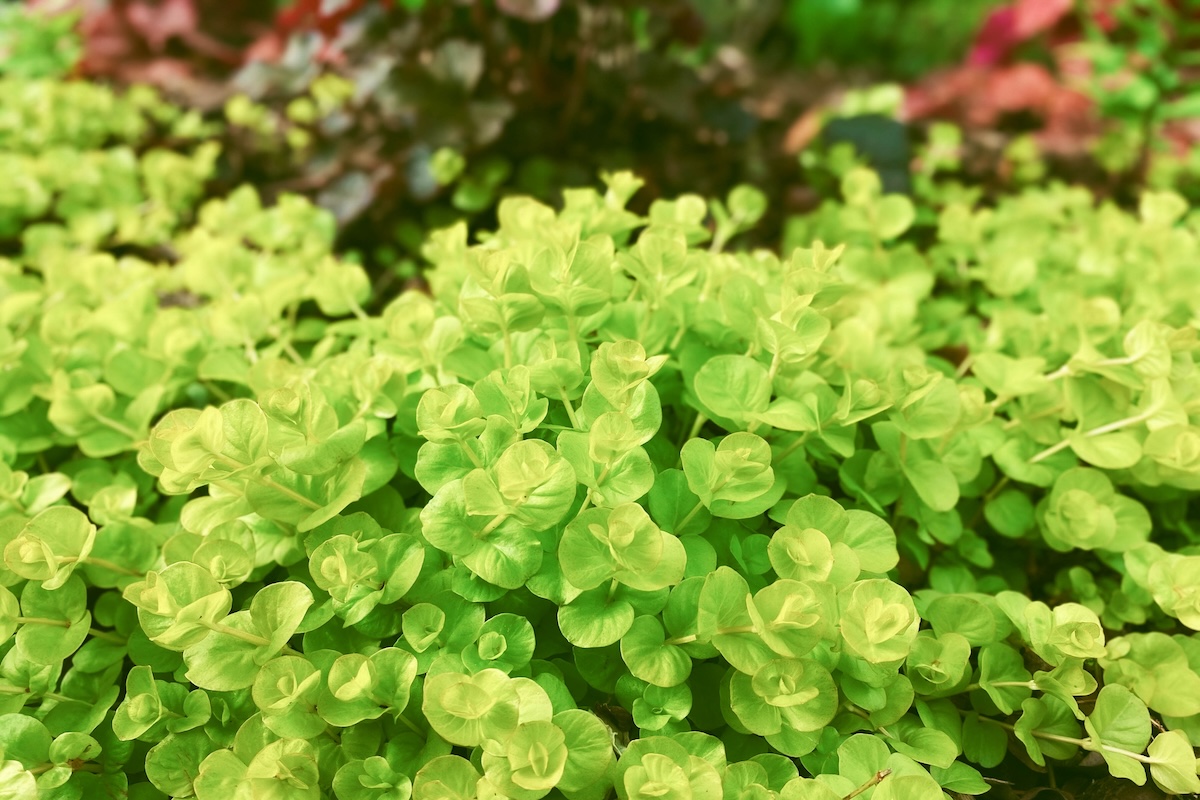
Equally at home hanging from a planter or covering a hillside, Lysimachia (more commonly known as creeping Jenny) is admired for its trailing branches. Each plant takes on a green fountain-like appearance: Long, lush shoots of chartreuse foliage sprout up from the soil, then softly twist and tangle for full coverage wherever planted.
Aside from good exposure to sunlight, these leafy green clusters ask little of their gardener with no need to replant every season. Note that the green type of European native can be highly invasive, especially in wet areas of the Northeast westward to Indiana, and in the parts of the Northwest.
Best for: Cascading from hanging baskets, rock walls, and along slopes.
USDA hardiness zones: 3 to 8
Size: 2 to 4 inches high; 1 to 2 feet around
Light: Full sun to partial shade
6. Stonecrop (Sedum spp.)
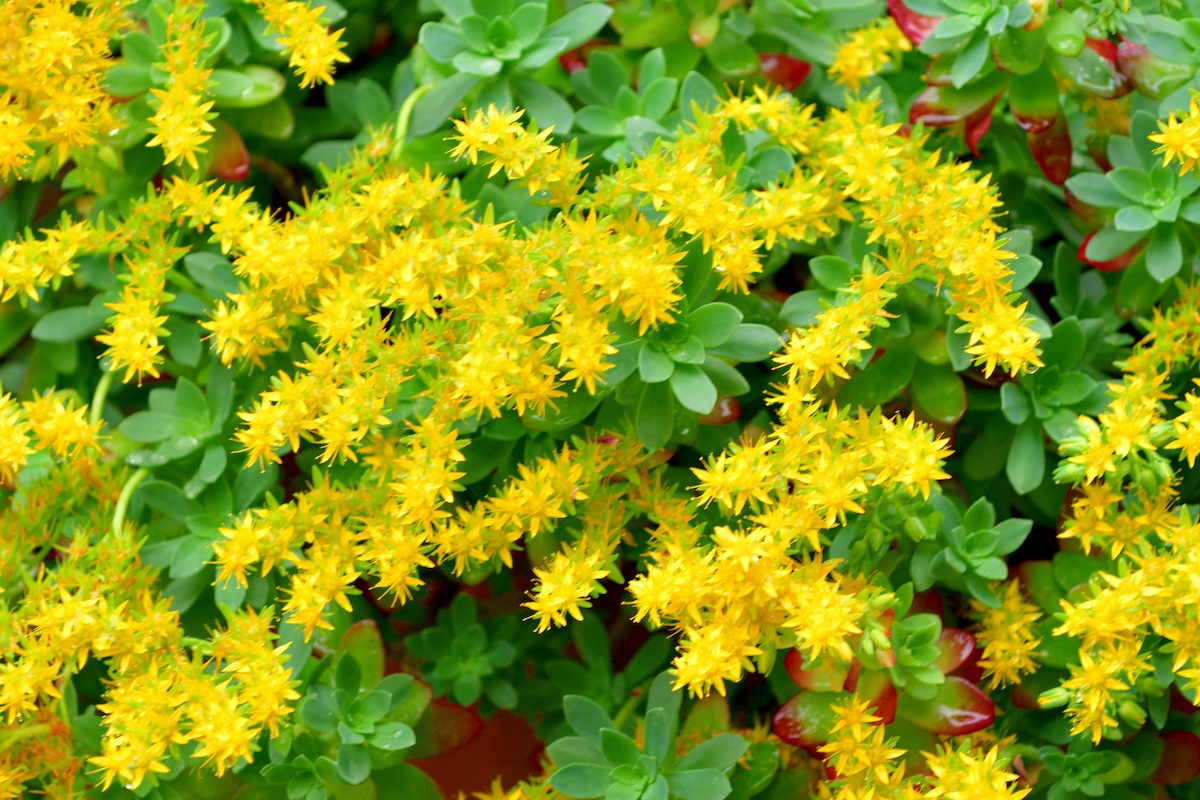
Need an easy evergreen carpet to plant where no grass dare grow? Though its lush leaves don’t scream “drought tolerant,” sedum boasts an ability to root and thrive in even the driest, rockiest settings, thus earning it the familiar name “stonecrop.” The secret? Those fleshy, bluish-green leaves help retain what little water it receives, allowing some varieties to bloom as well.
Many plant species from the genus Sedum are native to North America. Mulching and weeding can prevent unwanted weeds from stealing water from these low-maintenance succulents. Enjoy a varied choice of color and texture from this low-growing ground cover year-round.
Best for: Rock gardens and desert or drought-tolerant gardens, along with slopes.
USDA hardiness zones: 4 to 8
Size: 4 to 12 inches high, depending on type
Light: Full sun to partial shade
7. Periwinkle (Vinca minor)

The dainty lavender flowers and vining evergreen leaves make this purple ground cover incredibly popular as a low-maintenance ground cover for shade. Also known as periwinkle and creeping myrtle, vinca minor will spread wherever it’s planted and will even scale trellises or fences if trained.
Vinca has few pests, so some consider it invasive, which is good news if your goal is to keep weeds at bay. While this super spreader is a great ground cover to prevent weeds, you’ll need to cut it back on a regular basis to keep it from overtaking other plants. Beware of its potential invasiveness if you live near a forest, where its dense mats can threaten native plants on forest floors.
Best for: Rapid ground coverage in heavy shade or poor soil.
USDA hardiness zones: 4 to 9
Size: 3 to 6 inches high; 6 to 18 inches around
Light: Shade to full sun
8. Dead Nettles (Lamium)

Lamium can handle some of the most difficult growing conditions. The vining plant, also known as dead nettle, can tolerate cold, heat, and drought, and it’s deer resistant. There are more than 40 species of lamium, but the best are those that are flowering perennials, like Pink Chablis. The low-maintenance plant thrives year-round, rewarding you with delicate blooms in spring and summer.
Lamium spreads quickly, so be ready to cut it back if it begins to encroach on other shrubs and flowers. And beware that it is considered invasive in some areas of the Northeast and Northwest.
Best for: Naturalized areas with both sun and shade and deer resistance.
USDA hardiness zones: 3 to 8
Size: 3 to 10 inches high; 1 to 2 feet wide
Light: Full sun to full shade
9. Grace Ward Lithodora (Lithodora diffusa ‘Grace Ward’)

Thanks to its bold blue hue and its ability to attract butterflies, Grace Ward lithodora will add bursts of color to your landscape from spring through the end of summer. The low-lying ground cover is a popular option as a filler for rock gardens or as an accent above retaining walls. The plant also works as a natural deer repellent (the animals dislike the taste of the flowers) and helps control erosion.
Although not a U.S. native and with the potential to choke out nearby wildflowers, lithodora is not listed as an invasive concern.
Best for: Easy-care ground cover for erosion control and showy flowers.
USDA hardiness zones: 6 to 8
Size: ½ to 1 foot high; 2 to 2½ feet wide
Light: Full sun, afternoon shade in hotter regions
10. Creeping Thyme (Thymus serpyllum)

Soft, aromatic creeping thyme seems to check off all the boxes for a gardener, plus more. The low-lying, flowering ground cover can endure some foot traffic and is a smart choice for planting between pavers or for replacing grass entirely.
It prefers moderate climates but is able to withstand full sun and drought-like conditions. Creeping thyme ground cover is not invasive, helps prevent weeds from growing, and is a natural deer repellent. And while deer might not like its pink flowers, the blooms attract butterflies and honeybees. With proper care, the plant can last 5 to 6 years.
Best for: Flowering ground cover for sunny rock gardens and lawn replacement, especially along walkways.
USDA hardiness zones: 5 to 8
Size: 3 to 6 inches high, 3 to 12 inches around
Light: Full sun
11. Hardy Ice Plant (Delosperma cooperi)
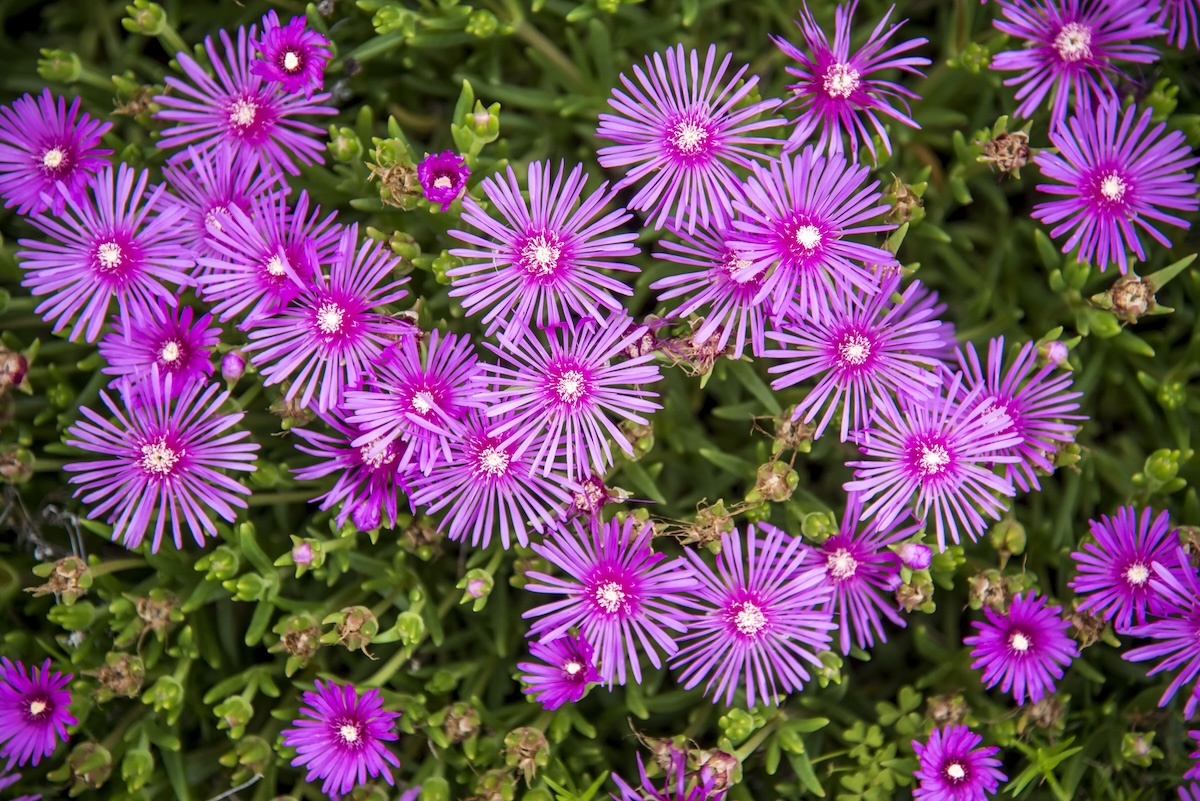
Native to Africa, purple ice plant (Delosperma cooperi) became popular as a cold-hardy ground cover in the United States in the 1990s. Although it favors dry climates, this ground cover can survive in the warmer end of some humid regions. It’s a well-behaved spreader, and is not invasive. If ice plants grow outside their bounds, trim them off or transplant a branch.
This deer-resistant succulent ground cover has needle-shaped leaves and small but bright daisy-like flowers that carpet the plants from late spring through early fall on evergreen foliage. New delosperma varieties boast yellow, orange, apricot, and bicolor flowers.
Best for: Sunny and dry conditions in rock gardens, to add color to cactus gardens, or to border garden beds.
USDA hardiness zones: 5 to 9
Size: 3 inches high; 1 to 2 feet wide
Light: Full sun
12. Native Zinnia (Zinnia spp.)
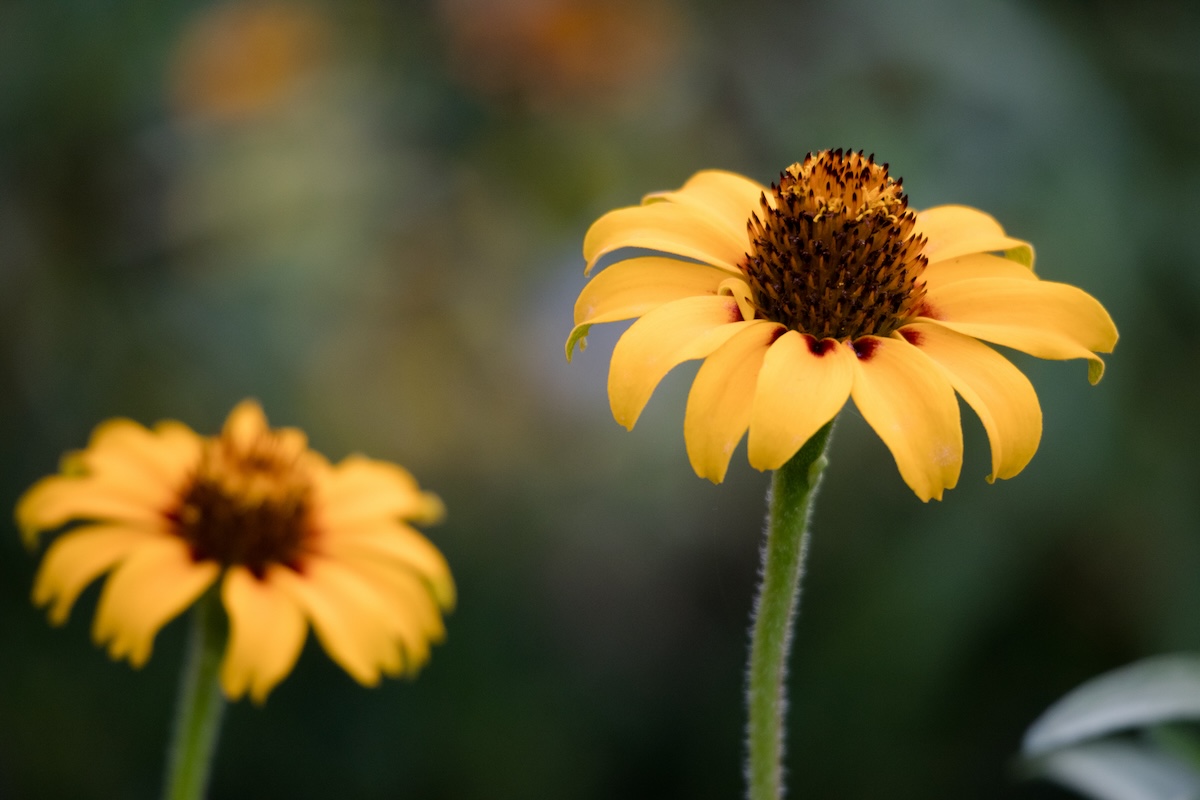
Though their growth habit is nothing like the annual zinnias of the same family, desert zinnia (Zinnia acerosa) and prairie zinnia (Zinnia grandiflora) are native ground covers in the Southwest. They love harsh conditions, including heat, full sun, low water, and even rugged terrain. Both have tiny needle-like foliage that spreads along the ground or down rock walls. They save their energy for the surprisingly large flowers, white on desert zinnia and yellow on prairie zinnia.
Best for: Flushes of summer color in rock gardens or as ground covers in poor or rocky soil.
USDA hardiness zones: 4 through 10, depending on type
Size: 4 to 8 inches high and around
Light: Partial shade to full sun
13. Yarrow (Achillea millefolium)

Although taller than a typical ground cover, yarrow ranks among the most attractive ground cover flowering plants. Common or Western yarrow, Achillea millefolium, is native to North America and grows throughout temperate regions. Some hybrids offer striking, flat flower clusters that bees and butterflies can use as a landing pad. In addition to white flowers, moonshine yellow, paprika, or vintage violet yarrow hybrids are available.
Yarrow can grow in full sun in nearly any soil and can tolerate drought once established. These creeping ground cover plants will reward you with easy care and bright colors.
Best for: Long-lasting foot-high native groundcover that attracts butterflies.
USDA hardiness zones: 3 to 9
Size: 1 to 3 feet high and wide
Light: Full sun
14. Catmint (Nepeta x faassenii)

Aromatic enough for both kitties and their owners, catmint (Nepeta) is an easy-care, low growing ground cover. Catmint is a relative of mint, so it’s guaranteed to spread, and it’s both cold-hardy and somewhat heat-tolerant. A particularly vigorous variety, Nepeta ‘Walker’s Low’, was The Perennial Plant Association’s plant of the year in 2007.
Catmint is an easy-to-grow, robust purple ground cover that can attract cats almost as much as true catnip (Nepeta cataria). Its aromatic grayish-green foliage spreads easily, and lavender-blue flowers rise on stalks from spring through fall. It spreads well, but is easy to manage.
Best for: Deep purple color that grows in a variety of soils and climate conditions, and is resistant to rabbits and deer.
USDA hardiness zones: 3 to 8
Size: 2 to 3 feet high and wide
Light: Full sun
15. Society Garlic (Tulbaghia violacea)

With society garlic, you can enjoy an edible ground cover. This tuberous perennial has long, thin, chive-like foliage you can enjoy in the kitchen; the greenery is topped by tiny purple flowers in the summer, and it’s also available in a variegated type. Society garlic can also tolerate hot and dry conditions.
It’s a good idea to add some mulch around the plant to help suppress weeds. As it spreads, new clumps will form. If your garlic outgrows its space, thin it out and divide the old clumps every few years for a consistent ground cover.
Best for: Edible ground cover for hot, sunny areas with rich, well-draining soil.
USDA hardiness zones: 7 to 10
Size: 12 to 24 inches high; 9 to 24 inches wide
Light: Full sun
